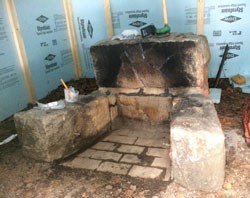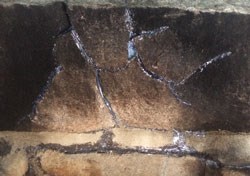Last updated: February 22, 2022
Article
Rehabilitating Historic Fire Pits at Acadia's Seawall Campground
Seawall Campground is one of two historic campgrounds in Acadia National Park (the other is Blackwoods Campground). It was built by the Works Projects Administration (WPA) between 1936 and 1942 as a program of Franklin D. Roosevelt’s New Deal.


Seawall's Historic Fire Pits
Seawall Camgpround and its granite fire pits were built following the rustic design style that was used throughout the western national Parks. The firepits were constructed with splayed low stone arms attached to a stone backing and a higher back wall. The higher back wall serves as the visual vestige of a chimney and is purely aesthetic, serving no useful purpose. The firebox is lined with beige firebrick. The cooking grate is fabricated from wide strips of cold-rolled milled steel, many of which are permanently fixed in place. Other individual fireplace units at Seawall feature a third splayed arm that serves as a prop on which rests a hinged fire grate. This third arm serves as a small but useful surface to aid in the preparation of meals. These fireplaces have long been recognized, however, for their high maintenance requirements.The rustic design style used natural topography and materials to preserve natural scenery in man-made spaces. In many ways, it defines what people think of as the 'national park experience.' At Seawall Campground, the rustic design style resulted in the use of granite foundations, board-and-batten siding, hand-split shingles (since replaced with asphalt), and hipped and bellcast roofs, which communicated a hierarchy of building types through their pitch.
As early as 1938, Albert Good wrote: " ... in spite of every possible structural precaution to insure long life, this kind of facility remains intact for scarcely one season under the hard use to which swarming hordes of picnickers subject it." Steel and concrete alternatives were soon developed, including that designed by Cook County Forest Preserve in Illinois, which served as the prototype for the contemporary fireplaces in widespread use at Acadia.
The fire pits in the A, B and C Loops are all original to the campground.
Rehabilitating the Historic Fire Pits
The historic granite fire pits at Seawall Campground are exposed to extreme weather. Over time water, ice, and extreme heat cause deterioration to the mortar, as well as causing cracks in the granite which get larger with time and conditions. When water gets into cracks during cold months, it freezes and expands, causing the cracks to get larger. Heat from large fires built in the pits can cause loosened pieces of rock to “pop” and extreme heat can split entire blocks.



The joints are repaired and re-mortared

NPS masons working under small heated mobile tents restored each individual fire pit to the historic standard.
Sitting around the campfire is something most campers look forward to, and for many it is the most relaxing and enjoyable way to end and begin their days at Seawall.
How Can Your Help Preserve These Historic Fire Pits?
Please respect these historic fire pits and treat them gently so that they can be enjoyed by generations of families to come.
- Do not build overly large fires that can burn hot against the stone backing.
- Do not sit or lean on the backing or stone arms. These are freestanding masonry structures and individual stones can topple.
- Granite is heavy! Please do not attempt to lift or move the fire pits in any way.
